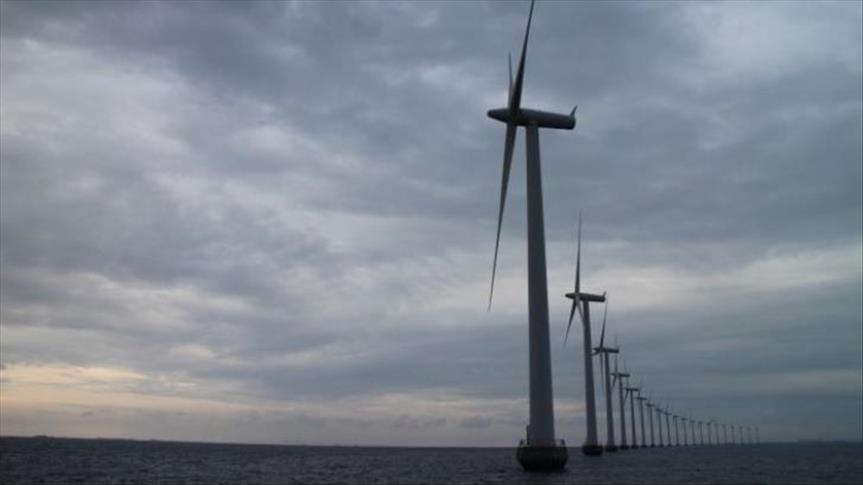Turkey's offshore wind potential is evident with the possibility of reaching 32 gigawatts amid the huge progress in recent years that has been made globally, WindEurope's CEO said on Sunday.
On Thursday, Feb. 22, Turkey's Energy and Natural Sources Minister Berat Albayrak announced that Turkey would hold its first offshore wind tender, the details of which will be revealed later in the year. In addition, further renewable projects, specifically solar and energy storage, are also planned.
Commenting on Turkey's wind potential, WindEurope CEO Giles Dickson said the wind energy sector in general grew over the last decade, but with the onset of floating offshore wind projects in Turkey, further opportunities for development have emerged.
"The relatively high sea depths around Turkey have perhaps held back initiatives to tap into this potential," he explained, but he added that floating offshore wind is now coming of age, which will allow wind turbines to be deployed in sea depths of more than 60 meters.
"This and investments in onshore transmission infrastructure could help Turkey exploit its offshore wind potential and add to the economic benefits wind power is already bringing to the country," he said.
He acknowledged the progress made in Europe's offshore wind sector and explained that it now represents 13 percent of the total wind power generated in Europe.
"And the costs have fallen spectacularly: auction prices were €150/megawatt-hours (MWh) three years ago, and now they're in the €60s. New offshore wind farms are now often delivering capacity factors of more than 50 percent," he said.
The winner of Turkey's first Renewable Energy Resource Zone Project (YEKA), Siemens Gamesa Renewable Energy Turkey CEO Hakan Yildirim said that with the newly announced tender for offshore wind power, Turkey is on the right path to be in the wind sector's first league.
"Particularly over the last decade, the country added 7 gigawatts (GW) of wind power installation to the country's total installed capacity. This installation helped Turkey's wind energy sector obtain experience in the business," he said.
However, with new YEKA projects, Turkey will not only gain further installed capacities, but will also take a positive step for the long term by developing the country's wind energy sector, he affirmed.
"In 1991, Siemens Gamesa launched the world's first offshore wind power plant. The company now has overall 11 GW of wind installed offshore capacity globally," he said.
According to Global Wind Energy Association (GWEC) data, London Array in the U.K. at 630 MW is the largest offshore wind power plant to date, but there are other bigger plants under construction.
According to GWEC, European countries, in particular, opt to have both onshore and offshore facilities. However, others like Japan with restricted acreage onshore prefer offshore wind.
"Germany and the U.K. have more onshore than offshore wind. Germany has 50,777 MW of onshore wind, 5,355 MW offshore; while the U.K. has 12,036 MW onshore and 6,836 MW offshore," GWEC stressed.
Offshore wind offers greater scale with bigger turbines and output, and therefore offshore wind speeds tend to be faster than on land. A small increase in wind speed yield means large increases in energy production.
Offshore wind offers benefits in the avoidance of land acquisition issues, steadier wind speeds than on land and this steadier supply means a more reliable source of energy for users close to coastal areas with very high energy needs.
Overall, offshore wind farms have many of the same advantages as land-based wind farms – they provide renewable energy; they do not consume water; they provide a domestic energy source; they create jobs, and they do not emit environmental pollutants or greenhouse gases.
-Global tender prices
According to GWEC data, the dramatic reduction in offshore wind prices started with the Dutch tender for Borssele 1 & 2 in June 2017, coming in at €72/MWh, well below expectations; followed by a Danish nearshore tender in September 2017 at €64/MWh.
"This was followed in November 2017 with the winning bid for the Danish Krieger’s Flak project coming in at an astonishing €49.90/MWh; and then Borssele 3 & 4 in the Netherlands coming in at €54.50/MWh in December," GWEC stated.
"And there was over 1 GW of capacity awarded in Germany last year, where the bid was for the wholesale price of electricity, i.e., no fixed tariff," according to GWEC.
- Technological difference between offshore and onshore wind
The wind turbines are generally larger in offshore wind power, in some cases much larger, especially the new generation of 6-9.5 MW turbines that are almost impossible to install on land for logistical reasons.
These offshore turbines are more robust, in the sense that they have more redundancies built in, given that maintenance operations are very expensive, while unplanned maintenance can be problematic especially in winter when access to the turbines could prove impossible.
The turbines for offshore facilities are built for and adapted to the marine environment, in terms of resistance to extreme weather conditions at sea. For instance, many will have a positive pressure system, i.e., making sure that clean filtered air inside the nacelle is at a higher pressure than outside. Consequently, should any leaks occur, air will flow out while ensuring that air, salt and water cannot enter.
The orientation and spacing of turbines have to be carefully calculated while taking into account the impact of ocean waves.
By Gulsen Cagatay & Nuran Erkul Kaya
Anadolu Agency
energy@aa.com.tr


